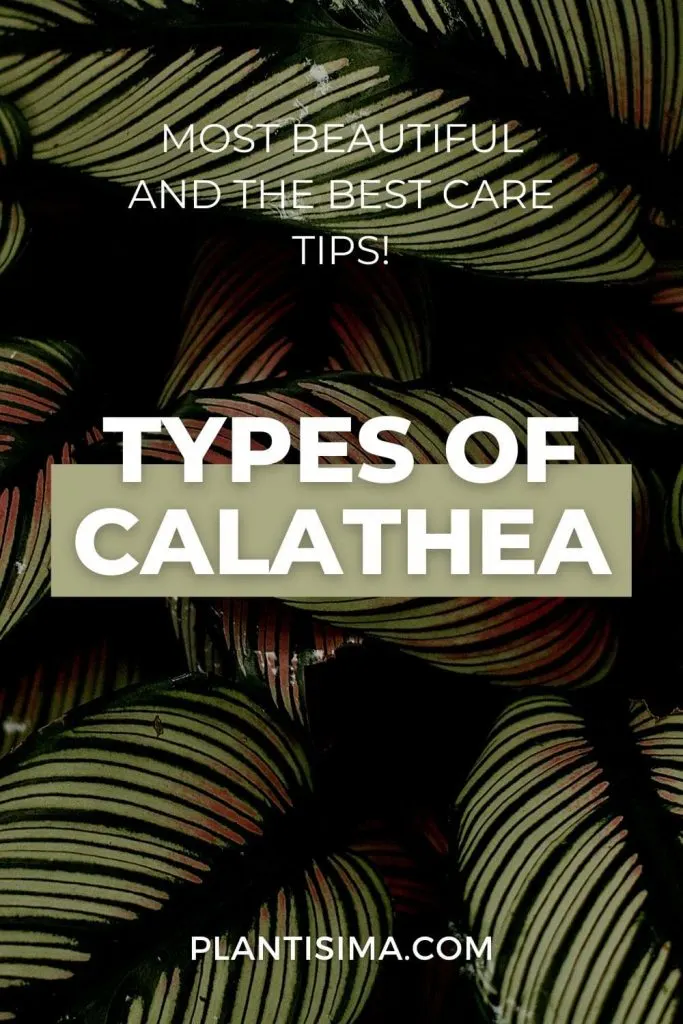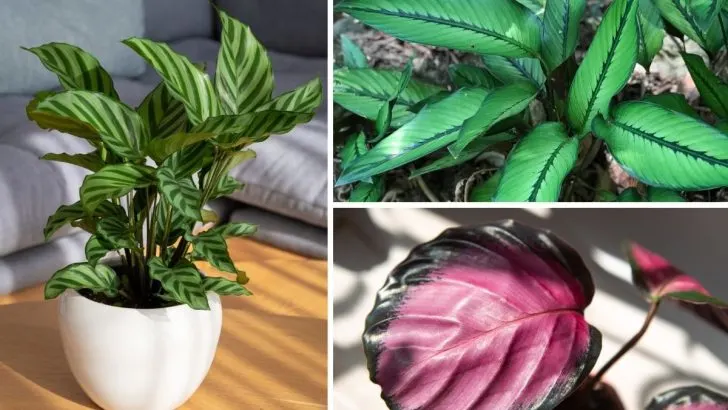If you’re looking for a showy houseplant that is for sure a heads turner, then the lovely plant calathea is the right pick for you. To be precise all types of calathea plants are a good fit for almost everybody!
With their beautiful deep green foliage and easy care requirements, these plants are perfect for anyone looking for a low-maintenance houseplant.
These beautiful calathea plant species are often used as houseplants because they require little maintenance and have interesting foliage. The velvety leaves go from light green to dark green leaves.
The genus Calathea is large and diverse, containing about seventy species and many more cultivars.
So if you are looking for a new plant for your indoor garden, be sure to check out the many different types and varieties of Calathes. You will not be disappointed!
1. Calathea Makoyana

Calathea makoyana is a species of flowering plant in the Marantaceae family. It is native to tropical America. Its locations are rain and cloud forests.
The plant grows as an evergreen shrub or small tree, reaching a height of 9 to 25 ft. The leaves are large, up to almost 2 ft long. They are divided into pinnate leaflets, which in turn are divided into lobes.
The flowers are small, in panicles up to 12 in long, and are white or cream-colored. It is a popular houseplant grown for its ornamental foliage.
To care for Calathea Makoyana you need a warm climate and high humidity.
She also needs indirect light, so put her in a spot where she’s not in direct sun, that is, on the partially shaded side of the room.
You should also water them regularly and make sure that the soil dries out between waterings.
The plant is not frost-hardy. Therefore you should bring it indoors when the temperature falls below 50°F.
2. Calathea Lancifolia: Rattlesnake Calathea Plant
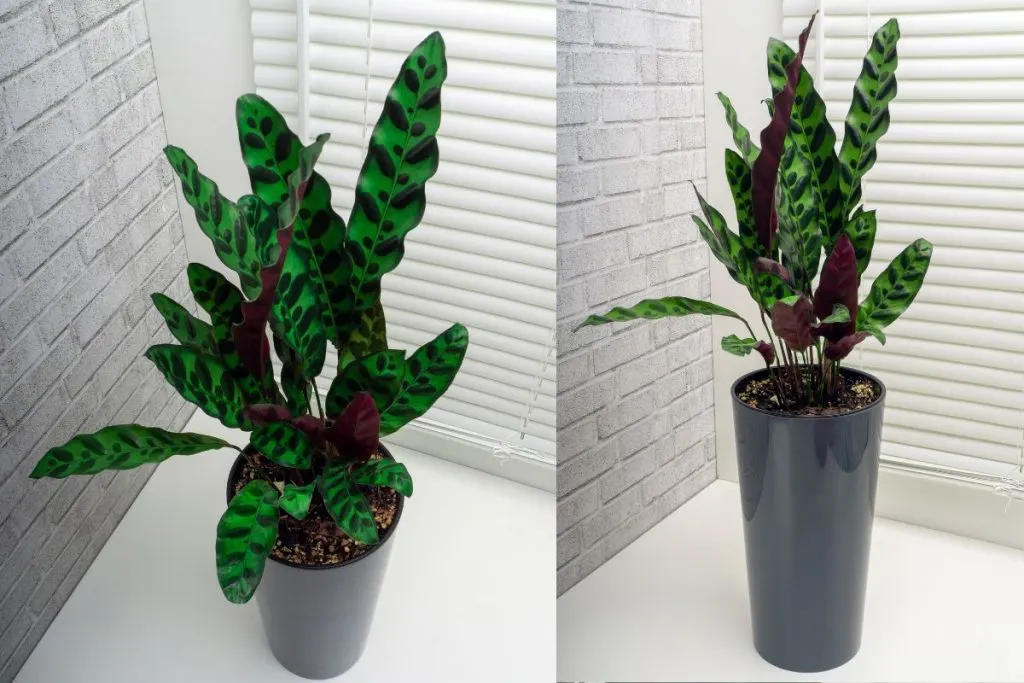
Calathea Lancifolia is a tropical plant native to Brazil. It owes its name “rattlesnake plant” to the shape of its leaves, which resemble the pattern on the back of a rattlesnake.
The leaves are dark green with silver veins running throughout the leaf and tinged deep purple undersides. The plant grows about 6 to 9 ft high and wide. If you are interested in more purple house plants take a look at our other articles.
Calathea Lancifolia thrives best in bright indirect sunlight and high humidity. It can be propagated by division or stem cuttings.
Fertilize every two weeks with a balanced liquid fertilizer when the plant is actively growing.
Allow the soil to dry out between waterings. Pothos plants make good companions to rattlesnake plants as they enjoy similar growing conditions.
It is a popular houseplant that is relatively easy to care for.
3. Calathea Rufibarba Beauty With Dark Green Leaves And Purple Undersides
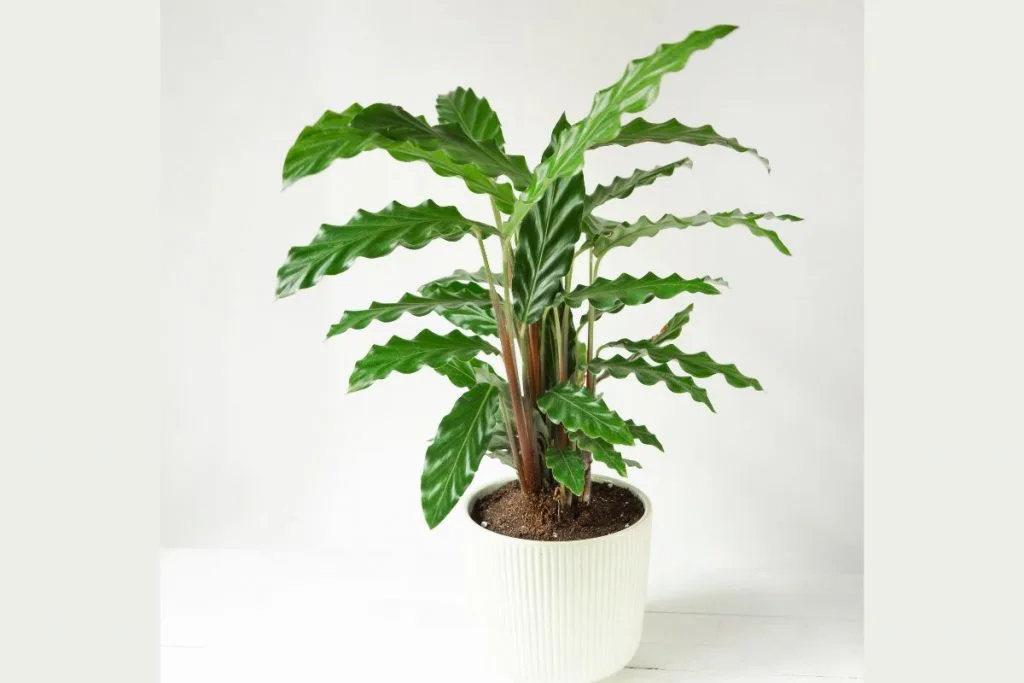
Velvet Calathea is a species of flowering plant in the Marantaceae family. It is native to Brazil, Colombia, and Venezuela.
This plant is an evergreen perennial that grows from a rhizome. Calathea leaves are dark green and ruffled, with a reddish underside. The flowers are small, white, and fragrant.
On the market, you can find Calathea rufibarba ‘Wavestar’, ‘Blue Grass’, or ‘Elger Grass’, among others.
Calathea rufibarba is a popular houseplant grown for its attractive foliage. She needs bright light, but not direct sunlight.
The soil should be moist but not wet. Fertilize every two weeks with a balanced fertilizer. Propagation is by division or stem cuttings.
C. rufibarba is a beautiful plant that is easy to care for. It makes a great addition to any home garden or indoor space.
4. Calathea Roseopicta (Rose Painted Calathea)

Types of Calathea are also varieties of Calathea roseopicta are tropical plants native to Central and South America. Calathea roseopicta is also called rose-painted calathea.
The plant grows in moist, shady areas and can reach a height of up to 20 ft.
It has long, lance-shaped green foliage, and oval-shaped leaves. They are dark green with a reddish-purple underside. The leaves have some small, black spots. A darker version is the calathea roseopicta dottie.
Calathea roseopicta produces small, white, fragrant flowers.
The plant is popular as a houseplant. It can grow in pots or in the garden bed. It thrives best in moist, well-drained soil and part shade.
Calathea roseopicta is a low-maintenance plant that thrives with little maintenance. As a houseplant, you use it to add color and richness to a room.
Calathea roseopicta has beautiful glossy dark green leaves. These dark green leaves are unique, making them a popular houseplant.
5. Calathea Zebrina (Zebra Plant)
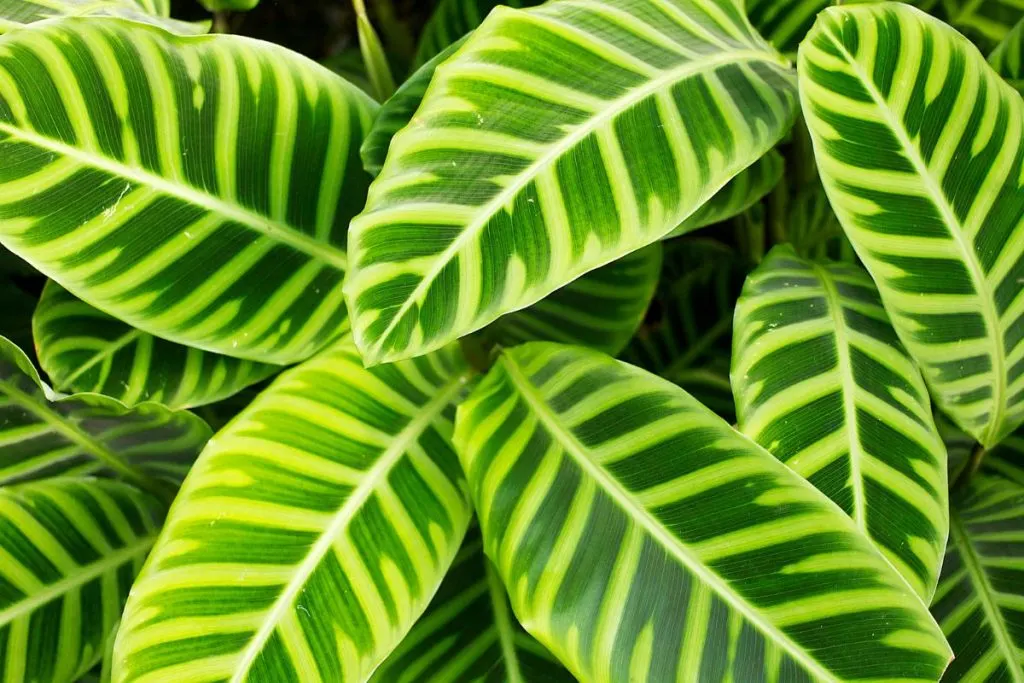
With this wicker plant in your living room, you get a real jungle feeling.
Calathea Zebrina is a tropical plant native to Brazil. It belongs to the Marantaceae family. The strikingly patterned leaves are the main reason to call the plant also zebra plant.
The plant grows to about 12 inches in height and has lanceolate and dark green leaves with white, pink stripes or light green stripes running the entire length. The flowers are small and white and they bloom in clusters.
Calathea zebrina is a popular houseplant because it is relatively easy to care for and its beautiful foliage enhances any interior.
The plant thrives best in bright indirect sunlight and high humidity.
Keep the plant moist but not wet, and the soil well-drained. Calathea zebrina is not cold-tolerant, so protect it from drafts.
If you are looking for impressive houseplants, then these Calathea varieties are the plants for you!
6. Calathea Orbifolia (Prayer Plant)
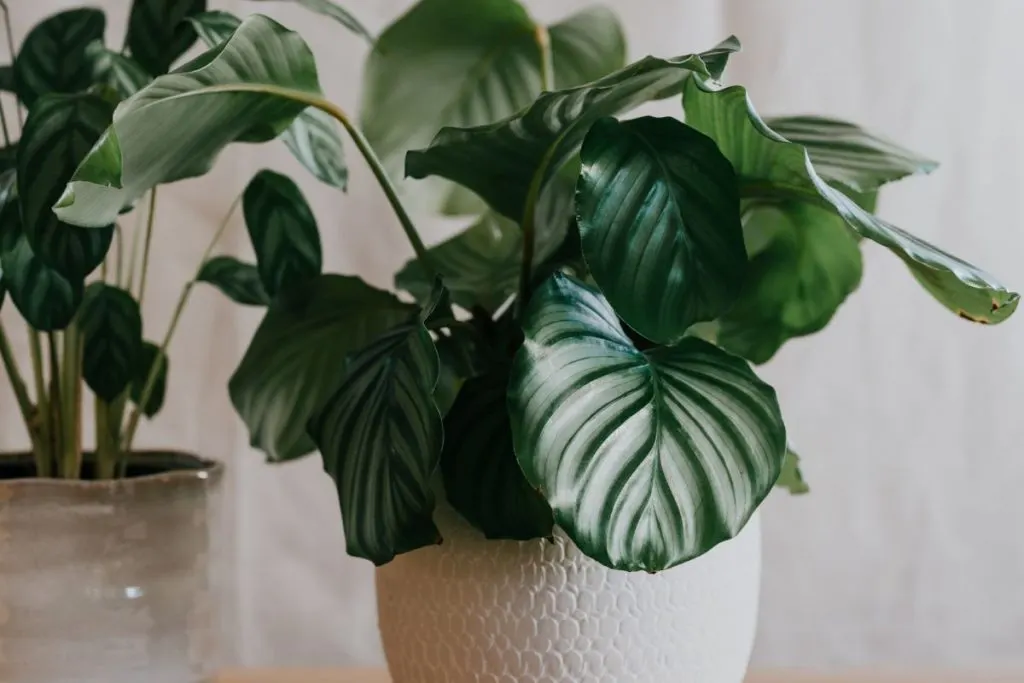
Calathea orbifolia is a tropical plant native to Brazil. It is an evergreen perennial with leaves that are green above and silver below.
This plant is a member of the Marantaceae family and still belongs to the ornamental foliage group.
This one is round leaf Calathea and the leaves also have top and deep purple stripes. Calathea orbifolia prefers moist, well-drained soil.
You can either add some organic matter to the soil before planting, or you can use potting soil especially made for tropical plants.
This plant does best in partial shade. If you’re growing her indoors, place her in a spot that gets bright indirect sunlight daily.
Water the Calathea orbifolia regularly. During watering do not get the leaves wet to avoid leaf spots. Allow the soil to dry out slightly between waterings.
7. Calathea Crocata: The Eternal Flame Plant
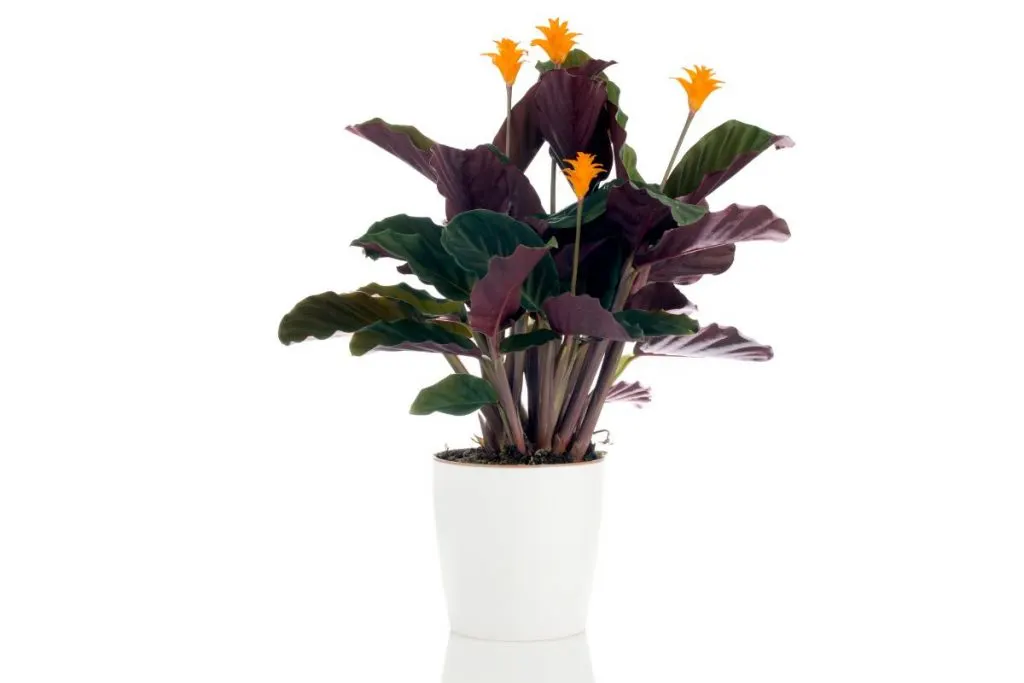
Calathea crocata is a beautiful plant commonly found in tropical rainforests. It has dark green leaves that are heavily veined and can grow up to 7 inches long.
The flowers of Calathea crocata are small and white and grow in clusters at the top of the plant.
This plant is a popular choice for indoor gardens as it does well in low-light environments. In addition, it is relatively easy to care for and only requires moderate moisture and water.
Calathea crocata can be propagated by division or stem cuttings. In flower arrangements, we often use the leaves of Calathea crocata.
Cutting the leaves releases a fragrant oil that smells of cinnamon. This plant is also known as “eternal flame” or “peacock plant” because of its unique flowers.
8. Calathea Warscewiczii

Calathea warscewiczii is a tropical plant typically found in the rainforest. It has dark green leaves highlighted by silver veins.
The leaves also feel fluffy. This plant grows best in moist, shady locations. And should be watered regularly. It is also important to keep the humidity high around this plant.
Calathea warscewiczii is best propagated by division. This can be done when repotting the plant. Simply divide the root ball into several sections, making sure each section has multiple leaves.
These cuts can then be placed in their own pots and watered well. This plant is a good choice for those looking for a low-maintenance tropical plant.
Calathea warscewiczii is unlikely to suffer from major problems and will thrive in the right conditions. It is also a beautiful addition to any home or garden.
9. Calathea Leopardina With Light Green Leaves
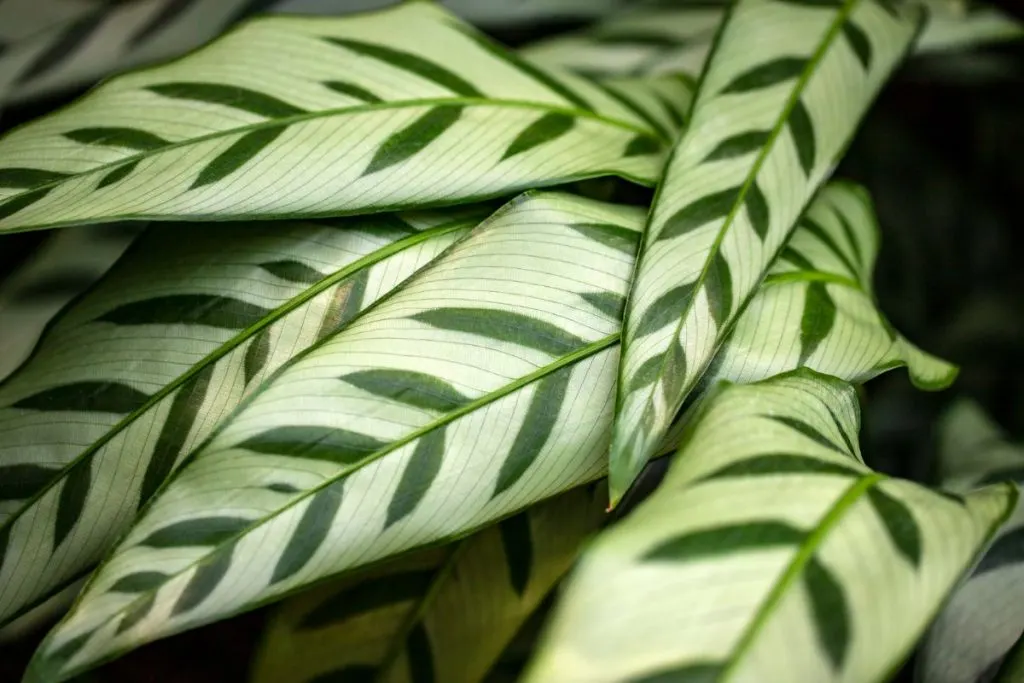
Calathea Leopardina is a popular houseplant known for its beautiful foliage. It is a tropical plant that originally comes from the rainforest and therefore needs high humidity and warm temperatures to thrive.
The leaves are from a lighter green leaf pattern to dark green with an intricate pattern resembling a leopard’s spots.
How to care for Calathea Leopardina:
Calathea Leopardina likes bright, indirect light and high humidity. She can be sensitive to drafts and temperature changes, so it’s important to keep her in a consistent environment.
Water when the top inch of soil is dry and mist the foliage regularly to increase humidity.
Calathea Leopardina is not tolerant of extreme cold or heat so it is best to keep it in a room that is around 70 °F. Fertilize once a month with a balanced houseplant fertilizer.
The Calathea Leopardina makes a beautiful addition to any home and is sure to be a conversation starter.
10. Calathea Ornata Plant
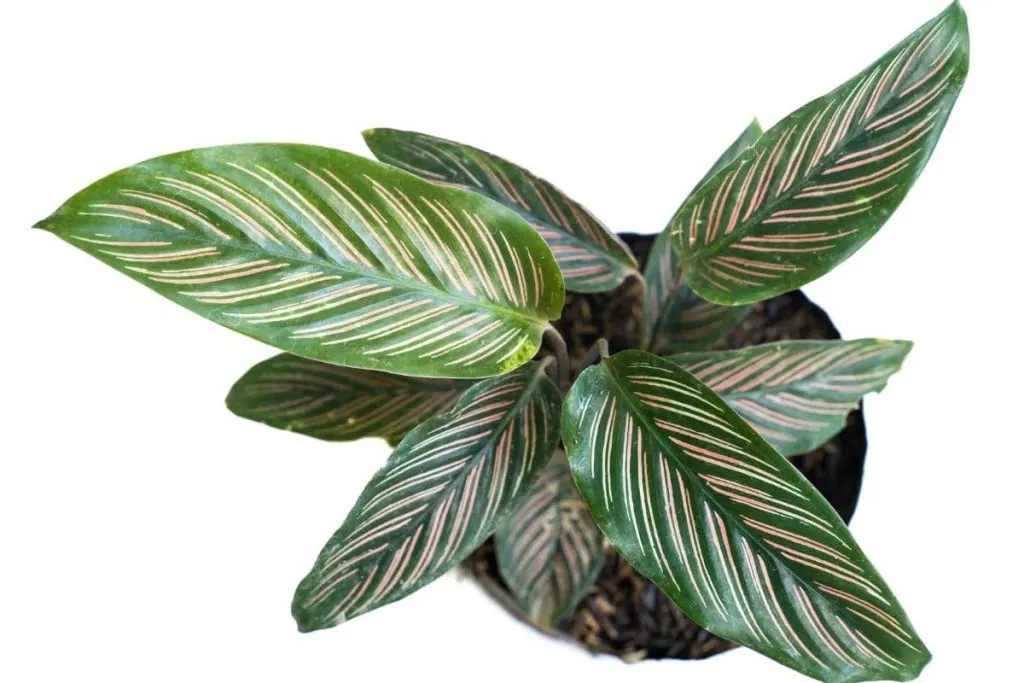
Calathea Ornata is a tropical plant native to Central and South America. It is an evergreen perennial with dark green leaves that are purple undersides.
In addition, the leaves feel velvety. The plant grows best in shady locations and in moist soil. It can be propagated by division or stem cuttings.
Calathea Ornata is a beautiful plant that will make a great addition to any indoor or outdoor space. It is relatively easy to care for and does not require much attention. With proper care, it will thrive and give you many years of enjoyment.
Feed Calathea Ornata every two to four weeks with a balanced fertilizer. A balanced fertilizer contains equal parts of nitrogen, phosphorus, and potassium.
You can also use a foliage plant fertilizer that is specially formulated for plants with dark green leaves. When dosing, be sure to follow the directions on the packaging.
Some varieties of this plant are Calathea beauty star, Calathea ornata sanderiana, Calathea ornata pinstripe, and others.
11. Calathea Insignis
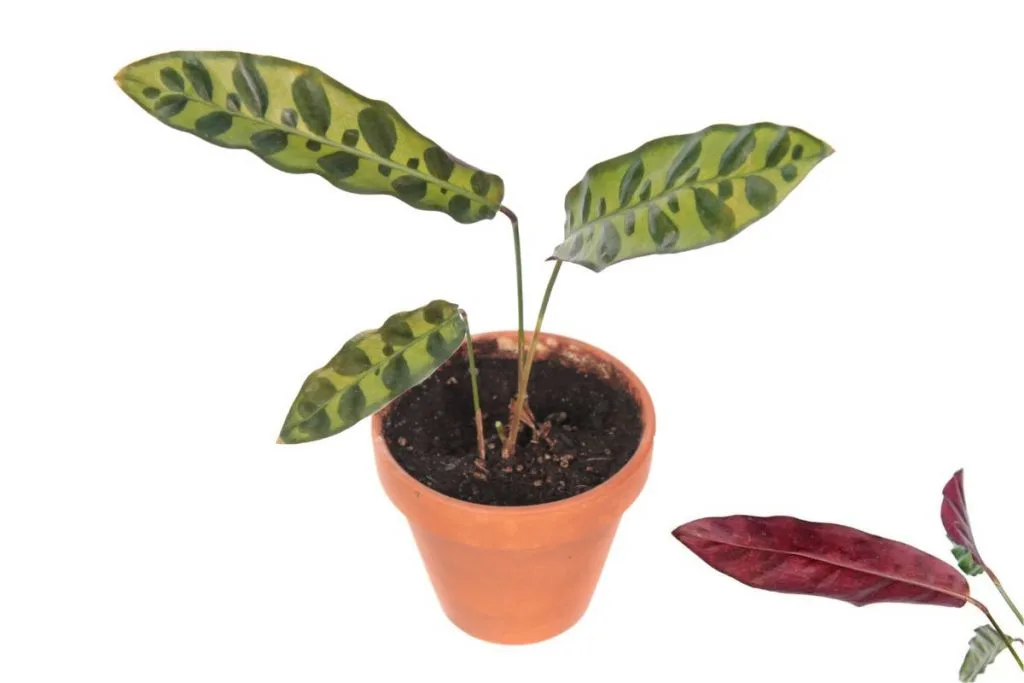
Calathea insignis is a species of flowering plant in the Marantaceae family. She is native to Ecuador, but it is not the national flower of Ecuador. Their natural habitats are subtropical or tropical moist lowland forests and subtropical or tropical moist montane forests.
Habitat loss is a threat. Although C. insignis is a tropical plant, it can also grow as a houseplant in temperate climates.
It prefers medium to high humidity and moist but not wet soil. It thrives best in partial sunlight, indirect sunlight, or shady locations.
The leaves of this plant are dark green with silver spots and it produces small white flowers.
C. insignis is a popular houseplant because it is easy to care for and has beautiful foliage. Propagation is by division or stem cuttings.
Types Of Calathea: Which Calathea Species For The Living Room?
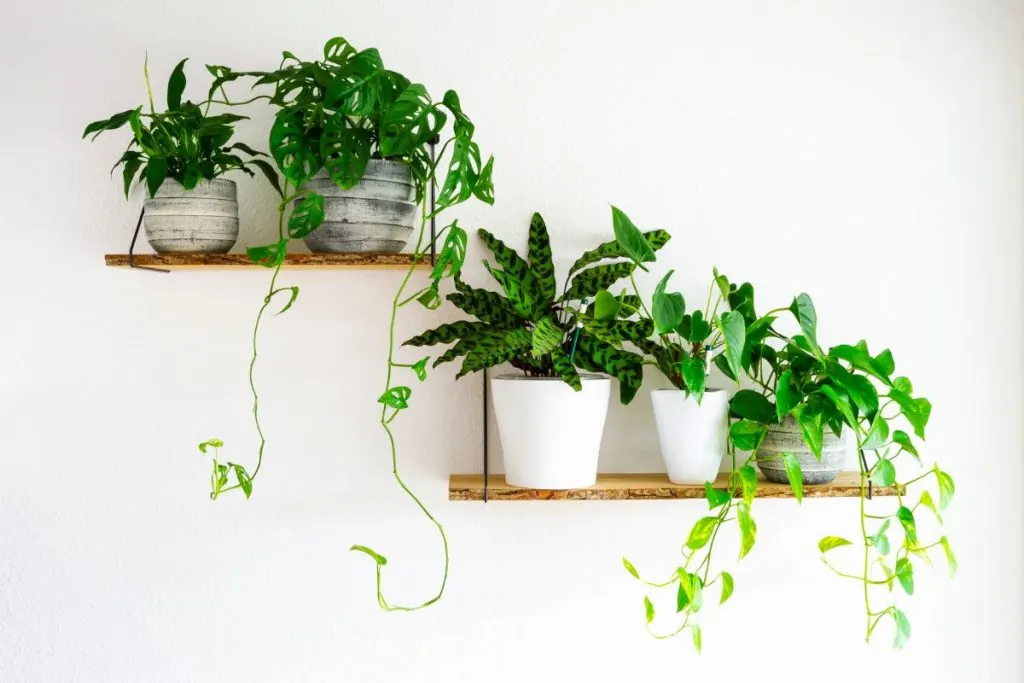
There are a few different calathea species that make excellent houseplants. My personal favorite is the Calathea orbifolia, which has beautiful dark green leaves with a purple underside.
Another good choice is the Calathea lancifolia, which has long, narrow leaves that are silver on top and green on the underside.
If you are looking for a calathea species that is sure to be an eye-catcher, consider the calathea zebrina. It has stunning zebra-striped leaves that are green on top and purple on the bottom.
Whichever calathea species you choose, they are sure to make a beautiful and unique addition to your home.
Types Of Calathea: How To Care For A Calathea Plant?

Calathea varieties are native to the tropical regions of South America. Beautiful, brightly colored leaves are the brand mark of all types of Calathea. Calathea plants are relatively easy to care for, but there are a few things to keep in mind when growing them.
Soil: Calathea plants prefer slightly acidic soil with a pH between 5 and 6.5. You can adjust the pH of your soil by adding lime or sulfur.
Light: Calathea plants prefer bright, indirect light. If they don’t, if they don’t get enough light, their leaves will lose their color.
Watering: Keep all types of Calathea plants moist but not wet. Allow the top layer of soil to dry out before watering again. Overwatering can cause the leaves to yellow and fall off.
Humidity: Calathea plants prefer humid conditions. When the air is too dry, the leaves turn brown and curl up.
Temperature: Calathea plants like warm temperatures and do not thrive well when the temperature drops below 60 degrees Celsius.
Fertilizing: Fertilize Calathea plants every two weeks during the growing season. Use a balanced fertilizer that contains both nitrogen and phosphorus.
Pests: Pests rarely attack all types of Calathea. But mealybugs, spider mites, and aphids can attack them. If you notice pests on your plant, treat them with an insecticide.
Caring for a calathea plant properly is not difficult, but it is important to heed the tips above. So with little effort, you get a large commission from this plant, a beautiful decoration for your own four walls!
With a little attention to detail, your calathea will thrive and brighten up your home for years to come.
Wrap Up About Type Of Calathea Plants
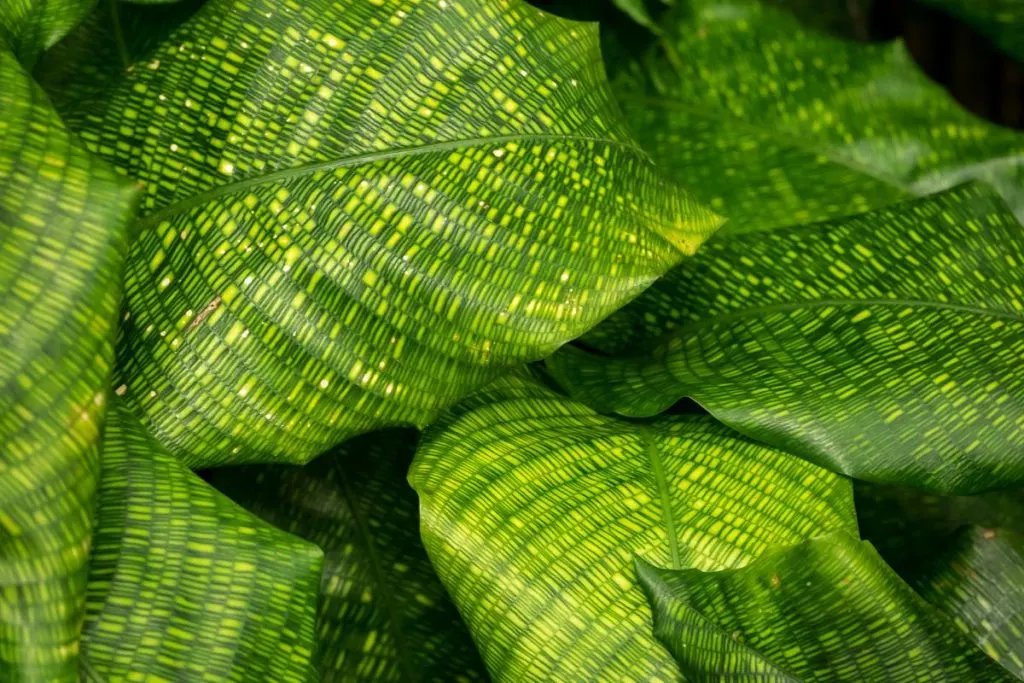
In our article, we could not mention all Calathea varieties. But what is certain is that every plant deserves an article about itself. Because all of them are special in their own way. Some of them are:
- Calathea musaica (Calathea musaica is the same as Calathea Network);
- Calathea white fusion;
- Ornata pinstripe calathea;
- Calathea Freddie…
